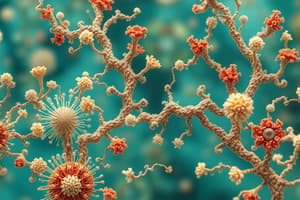Podcast
Questions and Answers
Match the following microbial characteristics with their descriptions:
Match the following microbial characteristics with their descriptions:
Rod-shaped cells = One of the most common cell shapes among microbes Pleomorphic cells = Cells that exhibit different shapes under different conditions or even in the same culture Haloquadratum = Microorganism with a flat, square shape Metabolic versatility = Enormous diversity in microbial metabolic capabilities allowing them to thrive in various habitats
Match the following terms related to microbial diversity with their meanings:
Match the following terms related to microbial diversity with their meanings:
Phylogeny = The evolutionary history and relationships among microorganisms Pathogenicity = The ability of microorganisms to cause disease Adaptation to environmental extremes = Microbial ability to survive and thrive in harsh environmental conditions Cell division mechanism = The process by which microbial cells reproduce and divide
Match the following time-related information with their descriptions:
Match the following time-related information with their descriptions:
14th September, 2023 = Date of the lecture on Microbial Biodiversity Nearly 4 billion years = Duration of microbial evolution resulting in the diversity of microorganisms 4 billion years = Time period contributing to the diversity of microorganisms Every potential habitat on Earth = Where prokaryotes thrive due to their metabolic versatility
Match the following ways to observe microbial diversity with their descriptions:
Match the following ways to observe microbial diversity with their descriptions:
Flashcards are hidden until you start studying
Study Notes
Microbial Characteristics
- Shape: Refers to the physical form of a microbe, which can be spherical, rod-shaped, spiral, or irregular.
- Size: Relates to the measurement of a microbe's dimensions, which can vary greatly between species.
- Motility: The ability of a microbe to move on its own, which can be achieved through flagella, cilia, or gliding.
- Gram Staining: A method of differentiating microbes based on their cell wall composition, resulting in either Gram-positive or Gram-negative staining.
Microbial Diversity
- Species Richness: The number of different microbial species present in a given environment.
- Community Composition: The variety of microbial species and their relative abundance in a specific ecosystem.
- Functional Diversity: The range of metabolic processes and ecological roles performed by microbes in a given environment.
Time-Related Information
- Generation Time: The time required for a microbe to complete one reproductive cycle.
- Lag Phase: The initial phase of microbial growth, characterized by slow growth and adaptation to the environment.
- Log Phase: The exponential growth phase of microbial growth, where cell division occurs rapidly.
Observing Microbial Diversity
- Microscopy: The use of light or electron microscopes to visualize microorganisms.
- Cultivation: The growth of microbes on artificial media, allowing for the isolation and characterization of species.
- Molecular Techniques: The application of genetic analysis, such as PCR or DNA sequencing, to study microbial diversity.
Studying That Suits You
Use AI to generate personalized quizzes and flashcards to suit your learning preferences.




